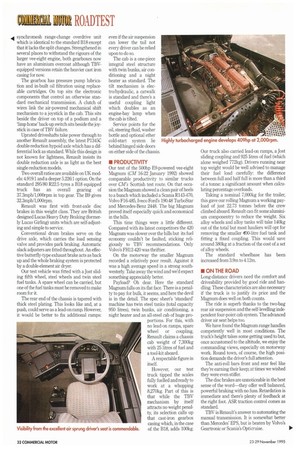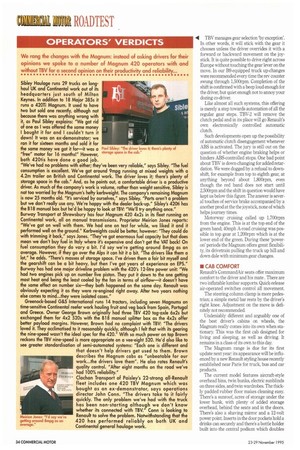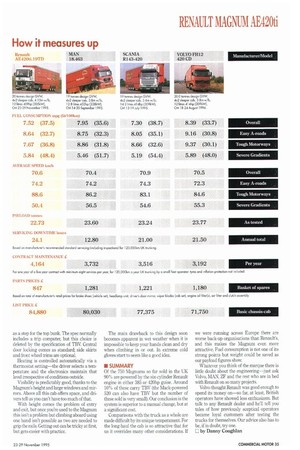HEAVYWEIGHT CONT ND R
Page 32

Page 34

Page 36

Page 37

If you've noticed an error in this article please click here to report it so we can fix it.
Five years on Renault's Magnum is still unique. But has the latest big cab competition caught up...and does TBV make the grade? CM thought it was time to find out.
Magnum remains a force to be reckoned with. Since its late-1990 launch 15,000 have been made and no-one has yet copied its flat-floor design. Larger cabs have appeared, including Leyland Oaf's Super SpaceCab and MAN's Roadhaus. But no truly comparable newcomer has emerged.
The only truck to come close is Navistar's Pro-Sleeper cabover, which was unveiled last March, but it is not available in Europe and even this mighty piece of Americana can only manage a flat floor above the Cummins Mll engine and with the driver and passenger seats in recessed fciotwells.
Magnum engineers have fought to keep its long wheelbase and large cab inside tight operational parameters. Trailer matching never became the problem some forecast for the UK; at around eight tonnes ready to work the average 4x2 tractor has not proved too heavy for this country.
And so to TBV So far Renault VI's electronic gearshift system is only available in the Magnum and left-hand-drive Majors. It is similar to Mercedes-Benz's EPS: like Mercedes and the rest (with the notable exception of Volvo) Renault has retained manual clutch control. But, also like everyone else, the company has a computerised clutch control system waiting in the wings for TBV-2.
This no-pedal system is being engineered into the next generation of heavy Renaults which are due to arrive next year. Whether the UK gets all the options depends largely on what you, the customer, demands.
The 420hp bracket keeps on growing. Sales in this class have never been higher; competition has never been tougher. To find out if the Magnum can hold its own we rang up Wellingborough's Harborne Group and wrestled a AE420ti.19TD TBV from their grasp. The truck in question is currently on longterm rental to Spalding-based Brown's Chilled Distribution; our thanks to them both.
• PRODUCT PROFILE The AE420ti.19TD is assembled at the sprawling Bourg-en-Bresse plant and is French from cab top to tail pipe.
Between its 6mm-thick main chassis rails lies Renault's own six-cylinder MIDR 06.35.40.J3 12-litre engine in Euro-1 tune. Highly turbocharged, this in-line motor develops 409hp (305kW) at 2,000rpm, and a middleof-the-road 1,460Ibft (1,980Nm) of torque in a narrow band around 1,200rpm.
It uses conventional Bosch mechanical injection and all-speed governing.
The clutch is an automatically adjusted Valeo twin-plate. The facings are organic. Actuation is air assisted hydraulic. The gearbox in our truck was Renault's nine-speed B9 110'
synchromesh range-change overdrive unit which is identical to the standard B18 except that it lacks the split changes. Strengthened in several places to withstand the rigours of the larger vee-eight engine, both gearboxes now have an aluminium overcoat although TBVequipped versions retain the heavier cast iron casing for now.
The gearbox has pressure pump lubrication and in-built oil filtration using replaceable cartridges. On top sits the electronic components that control an otherwise standard mechanical transmission. A clutch of wires link the air-powered mechanical shift mechanism to a joystick in the cab. This sits beside the driver on top of a podium and a 'limp home' back-up switch sits beside the joystick in case of TBV failure.
Uprated driveshafts take power through to another Renault assembly, the latest P1345C double-reduction hypoid axle which has a differential lock as standard. While this design is not known for lightness, Renault insists its double reduction axle is as light as the best single-reduction models.
Two overall ratios are available on UK models: 4.919:1 and a deeper 5226:1 option. On the standard 295/80 R22.5 tyres a B18 equipped truck has an overall gearing of 37.3mph/1,00Orpm in top gear. The B9 gives 32.3mph/1,000rpm.
Renault was first with front-axle disc brakes in this weight class. They are British designed Lucas Heavy Duty Braking (formerly Lucas Girling) units which are self-adjusting and simple to service.
Conventional drum brakes serve on the drive axle, which carries the load sensing valve and provides park braking. Automatic slack adjusters are fitted throughout. An effective butterfly-type exhaust brake acts as back up and the whole braking system is protected by a double-element air dryer.
Our test vehicle was fitted with a Jost sliding fifth wheel, steel wheels and twin steel fuel tanks. A spare wheel can be carried, but one of the fuel tanks must be removed to make room for it.
The rear end of the chassis is tapered with thick steel plating. This looks like and, at a push, could serve as a lead-on ramp. However, it would be better to fix additional ramps: even if the air suspension can lower the tail not every driver can be relied upon to do so.
The cab is a one-piece integral steel structure with twin bunks, air conditioning and a night heater as standard. The tilt mechanism is electro/hydraulic, a catwalk is standard and there's a useful coupling light which doubles as an engine-bay lamp when the cab is tilted.
Service points for the oil, steering fluid, washer bottle and optional ether cold-start system lie behind hinged side doors on either side of the chassis.
• PRODUCTIVITY Our test of the 500hp E9-powered vee-eight Magnum (CM 16-22 January 1992) showed comparable productivity to similar trucks over CM'S Scottish test route. On that occasion the Magnum showed a clean pair of heels to a bunch which included a Scania R143-470, Volvo F16-485, Iveco Ford's 190.48 TurboStar and Mercedes-Benz 2448. The big Magnum proved itself especially quick and economical in the hills.
This time things were a little different. Compared with its latest competitors the 420 Magnum was slower over the hills but its fuel economy couldn't be faulted, sticking religiously to TBV recommendations. Only Volvo's FH12-420 was thriftier.
On the motorway the smaller Magnum recorded a relatively poor result. Against it was a high average speed in a strong southwesterly. Take away the wind and we'd expect something appreciably better.
Payload? Oh dear. Here the standard Magnum falls on its flat face. There is a penalty to pay for bulk, it seems, and here the devil is in the detail. The spec sheet's 'standard' machine has twin steel tanks (total capacity 950 litres), twin bunks, air conditioning, a night heater and an all-steel cab of huge proportions. For this, with no lead-on ramps, spare wheel or coupling, Renault claims a chassis cab weight of 7,300kg with 25 litres of fuel and a tool-kit aboard.
A respectable figure in itself.
However, our test truck tipped the scales fully fuelled and ready to work at a whopping 8,270kg. Part of this is that while the TBV mechanism by itself attracts no weight penalty, its selection calls up that cast-iron gearbox casing which, in the case of the B18, adds 100kg. Our truck also carried lead-on ramps, a Jost sliding coupling and 925 litres of fuel (which alone weighed 772kg). Drivers running near top weight would be well advised to manage their fuel load carefully: the difference between full and half full is more than a third of a tonne: a significant amount when calculating percentage overloads.
Taking a nominal 7,000kg for the trailer, this gave our rolling Magnum a working payload of just 22.73 tonnes before the crew climbed aboard. Renault can fit some aluminium componentry to reduce the weight. Six alloy wheels and alloy tanks will take 140kg out of the total but most hauliers will opt for removing the smaller 400-litre fuel tank and fitting a fixed coupling. This would save around 380kg at a fraction of the cost of a set of alloy wheels.
The standard wheelbase has been increased from 3.9m to 4.12m.
• ON THE ROAD Long-distance drivers need the comfort and driveability provided by good ride and handling. These characteristics are also necessary if the truck is to justify its price and the Magnum does well on both counts.
The ride is superb thanks to the two-bag rear air suspension and the self-levelling independent four-point cab system. The advanced driver air seat helps too.
We have found the Magnum range handles competently well in most conditions. The truck's height takes some getting used to but, once accustomed to the altitude, we enjoy the commanding views, especially on motorway work. Round town, of course, the high position demands the driver's full attention.
The anti-roil bars front and rear feel like they're earning their keep; at times we wished they were even stiffer.
The disc brakes are unnoticeable in the best sense of the word—they offer well balanced, powerful braking with no fuss. Retardation is immediate and there's plenty of feedback at the right foot. ASR traction control comes as standard.
TBV is Renault's answer to automating the manual transmission. It is somewhat better than Mercedes' EPS, but is beaten by Volvo's Geartronic or Scania's Opticruise.
41 TBV manages gear selection 'by exception'. In other words, it will stick with the gear it chooses unless the driver overrides it with a forward or backward movement on the joystick, It is quite possible to drive right across Europe without touching the gear lever on the move. In our BO-equipped truck up-changes were recommended every time the rev counter swung through 1,500rpm. Completion of the shift is confirmed with a beep loud enough for the driver, but quiet enough not to annoy your dozing co-driver.
Like almost all such systems, this offering is merely a step towards automation of all the regular gear steps. TBV-2 will remove the clutch pedal and in its place will go Renault's own electronically controlled automatic clutch.
Such developments open up the possibility of automatic clutch disengagement whenever ABS is activated. The jury is still out on the question of whether engine braking helps or hinders ABS-controlled stops. One bad point about TBV is down-changing for added retardation. We were dogged by a refusal to downshift, for example from top to eighth gear, at anything beyond about 1.800rpm, even though the red band does not start until 2,500rpm and the shift in question would have kept us below this figure. The answer is several touches of service brake accompanied by a another prod at the the joystick, none of which helps journey times.
Motorway cruising called up 1,700rpm from the engine. This is at the top end of the green band; 40mph A-road cruising was possible in top gear at 1,200rpm which is at the lower end of the green. During these 'poweron' periods the Magnum offers great flexibility, its drivetrain pulling the truck up hill and down dale with minimum gear changes.
• CAB COMFORT
Renault's CommandAir seats offer maximum comfort to the driver and his mate. There are two inflatable lumbar supports Quick-release air-operated switches control all movement.
The steering column clamp is more pedestrian; a simple metal bar rests by the driver's right knee. Adjustment on the move is definitely not recommended.
Undeniably different and arguably one of the best driver's cabins on wheels, the Magnum really comes into its own when stationary. This was the first cab designed for living and sleeping, as well as driving. It remains in a class of its own to this day.
The Magnum range is due for its first update next year: its appearance will be influenced by a new Renault styling house recently established near Paris for truck, bus and car products.
The current model features aircraft-style overhead bins, twin bunks, electric sunblinds on three sides, and twin wardrobes. The thickly padded rubber floor makes cleaning easy. There's a sunroof, acres of storage under the lower bunk, with plenty of added storage overhead, behind the seats and in the doors. There's also a shaving mirror and a 12-volt power point. Inserts in the door pockets hold a drinks can securely and there's a bottle holder built into the central podium which doubles
as a step for the top bunk. The spec normally includes a trip computer, but this choice is deleted by the specification of TBV. Central door locking comes as standard; side skirts and front wheel trims are optional.
Heating is controlled automatically via a thermostat setting-the driver selects a temperature and the electronics maintain that level irrespective of conditions outside.
Visibility is predictably good, thanks to the Magnum's height and large windows and mirrors. Above all this cab offers space, and drivers tell us you can't have too much of that.
With height comes the problem of entry and exit, but once you're used to the Magnum this isn't a problem but climbing aboard using one hand isn't possible as two are needed to grip the rails. Getting out can be tricky at first, but gets easier with practice.
The main drawback to this design soon becomes apparent in wet weather when it is impossible to keep your hands clean and dry when climbing in or out. In extreme cold gloves start to seem like a good idea.
• SUMMARY
Of the 750 Magnums so far sold in the UK 90% are powered by the six-cylinder Renault engine in either 385 or 420hp guise. Around 10% of these carry TM/ (the Mack-powered 520 can also have TBV but the number of these sold is very small). Our conclusion is the system is superior to a manual change, but at a significant cost.
Comparisons with the truck as a whole are made difficult by its unique temperament. For the long-haul the cab is so attractive that for us it overrides many other considerations. If
we were running across Europe there are worse back-up organisations than Renault's, and this makes the Magnum even more attractive. Fuel consumption is not one of its strong points but weight could be saved as our payload figures show.
Whatever you think of the marque there is little doubt about the engineering-just ask Volvo, MAN, ZF and the rest who are in bed with Renault on so many projects.
Volvo thought Renault was good enough to spend its money on-so far, at least, British operators have showed less enthusiasm. But talk to any Renault dealer and he'll tell you tales of how previously sceptical operators became loyal customers after testing the trucks for themselves. Our advice also has to be, if in doubt, try one.
G by Danny Coughlan












































































































